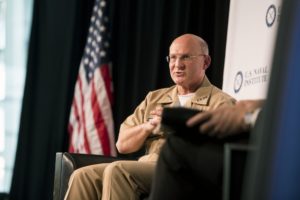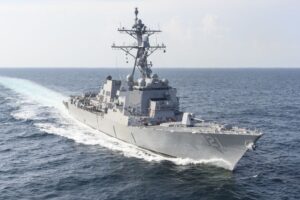The Chief of Naval Operations (CNO) on Wednesday said the defense industry is not ready to build up to three Arleigh Burke-class (DDG-51) destroyers, even while Congress is looking to pass legislation allowing the Navy to buy that many.
“So right now, the Congress, at least in the current budget that’s up on the Hill, there is a proposal to increase destroyers to three a year, if the industrial base can support that…Right now, we are not at a point where the industrial base is supporting three destroyers a year. Right now, there’s somewhere between two and two and a half. And so we want to make sure if we’re gonna put that money down against shipbuilding, that the capacity is actually there. So that that money is well spent,” Adm. Mike Gilday said on Sept. 14 during a virtual Defense One event.

The Navy’s fiscal year (FY) 2023 budget request sought authority to award another five year multi-year procurement contract for nine more destroyers with an option for a 10th ship. The Navy plans to buy two per year from FY ‘23 to 2027 (Defense Daily, April 26).
The destroyers are built by both General Dynamics’ Bath Iron Works [GD] in Bath Maine and HII’s Ingalls Shipbuilding [HII] in Pascagoula, Miss.
However, congressional FY ‘23 defense authorization bills in both chambers are poised to add to the multi-year contract and allow the Navy to buy up to 15 destroyers over five years. That would mean each shipbuilder producing 1.5 destroyers per year.
The CNO characterized the combined industry capability as lying between two and two and a half destroyers per year while the authorization bills envision three destroyers per year.
Gilday said pushing the shipbuilders to have the capacity to build that many ships over the period is dependent on sending a clear signal via actual funding, which comes from the defense appropriations process.
“Sending them a clear signal, I think of two to three DDGs a year in terms of that example, is an important signal to send, and not to keep on shifting those numbers back and forth from year to year.”
This elaborates on what Gilday commented last month, that sending industry a clear aim point on how many ships of which types the Navy wants with a higher degree of confidence the funding will come through is required to get to that larger shipbuilding result (Defense Daily, Aug. 29).
Gilday is trying to push for that confidence in part via his latest Navigation Plan released in July. The plan called for the Navy to move to over 350 manned ships by 2045, including 96 large surface combatants like the Arleigh Burke-class destroyers and follow-on DDG(X) destroyer (Defense Daily, July 26).
Gilday also underscored the Navy’s budget proposals and plans on how many ships to procure is dependent on the top line the White House and Department of Defense provide.
“And so we need to stay within that line as we propose a budget that reflects our true priorities,” he said.
Notably, in July a White House Statement of Administration Policy said it strongly opposed incrementally funding one third destroyer in FY ‘23 being pushed by the House Armed Services Committee’s defense authorization bill (Defense Daily, July 12).

The CNO also said the bottleneck in increasing shipyard building capacity is not just in the larger shipyards but is “across the board.”
He argued that while destroyer construction is improving, the service has seen construction challenges in the industrial base on building submarines and aircraft carriers on schedule and on time as well and it is all partially related to COVID-19 pandemic workforce issues.
“A lot of that has to do with the workforce as we recover from COVID. That’s not an excuse. It’s just where we are in this country right now. And so that skilled manual labor force is something that those companies are laser focused on so that they can grow that talent and sustain it. But again, that also comes down to, we shouldn’t expect them to make that kind of investment in a workforce or infrastructure in their facilities, unless we’re providing a steady demand signal.”
Relatedly, Rep. Elaine Luria (D-Va.) also spoke during the Defense One event that she is optimistic moving from 9-10 to 15 ships over the next five years is possible.
As a proponent of the House bill authorizing 15 destroyers, she said that “we’re really optimistic about Bath Iron Works and Pascagoula being able to get to a combined three ships a year. And we need to leverage our industrial capacity in order to build the fleet that we need.”